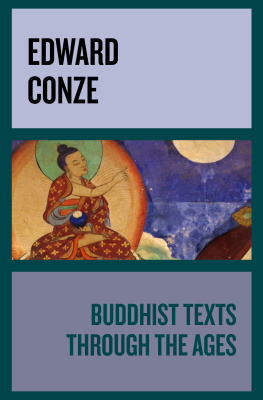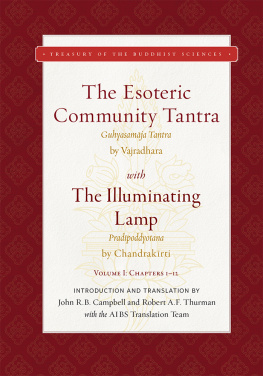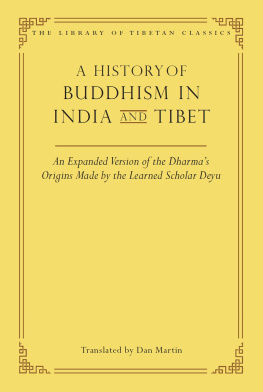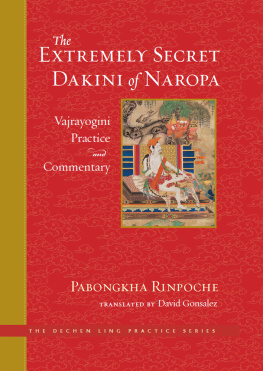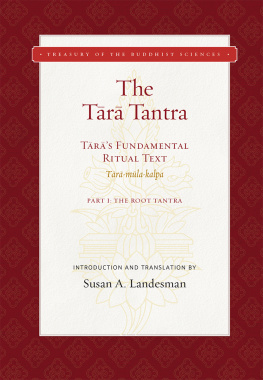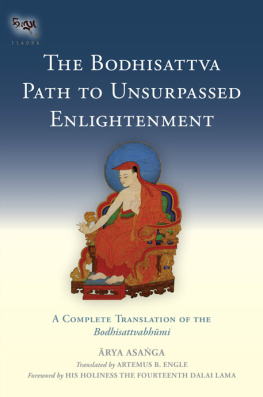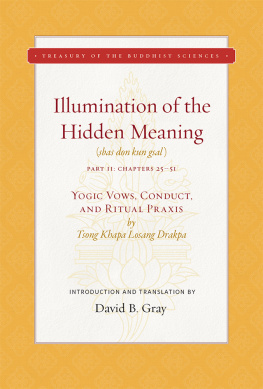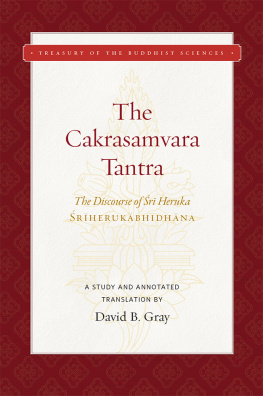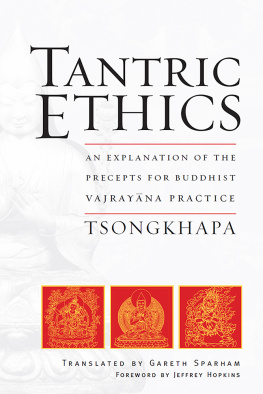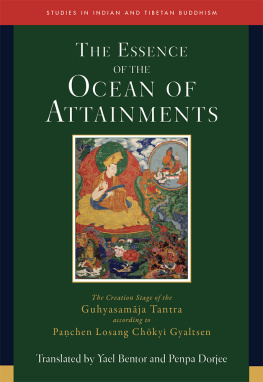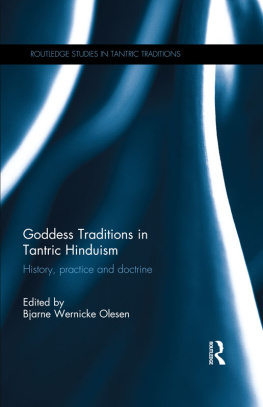VAJRAYOGIN
Studies in Indian and Tibetan Buddhism
THIS SERIES WAS CONCEIVED to provide a forum for publishing outstanding new contributions to scholarship on Indian and Tibetan Buddhism and also to make accessible seminal research not widely known outside a narrow specialist audience, including translations of appropriate monographs and collections of articles from other languages. The series strives to shed light on the Indic Buddhist traditions by exposing them to historical-critical inquiry, illuminating through contextualization and analysis these traditions unique heritage and the significance of their contribution to the worlds religious and philosophical achievements.
Members of the Editorial Board:
Tom Tillemans (chair), University of Lausanne
Jos Cabezn, University of California, Santa Barbara
Georges Dreyfus, Williams College, Massachusetts
Janet Gyatso, Harvard University
Paul Harrison, University of Canterbury, New Zealand
Toni Huber, Victoria University, New Zealand
Shoryu Katsura, Hiroshima University
Thupten Jinpa Langri, Institute of Tibetan Classics, Montreal
Frank Reynolds, Emeritus, University of Chicago
Leonard van der Kuijp, Harvard University
Cristina Scherrer-Schaub, University of Lausanne
E. Gene Smith, Tibetan Buddhist Resource Center, New York
Ernst Steinkellner, University of Vienna

Wisdom Publications
199 Elm Street
Somerville, Massachusetts 02144 USA
www.wisdompubs.org
2002 Elizabeth English
All rights reserved.
No part of this book may be reproduced in any form or by any means, electronic or mechanical, including photocopying, recording, or by any information storage and retrieval system or technologies now known or later developed, without permission in writing from the publisher.
Library of Congress Cataloging-in-Publication Data
English, Elizabeth
Vajrayogin : Her visualizations, rituals, & forms : a study of the cult of Vajrayogin in India / Elizabeth English
p. cm. (Studies in Indian and Tibetan Buddhism)
Includes bibliographical references and index.
ISBN 0-86171-329-X (alk. paper)
1. Vajrayogin (Buddhist deity) 2. Tantric BuddhismRituals.
I. Title. II. Title: Vajrayogin. III. Series.
BQ4890.V344E65 2002
294.3'42114dc21 2002011148
ISBN 0-86171-329-X
First Wisdom Edition
06 05 04
5 4 3 2
Designed by Gopa and Ted2
Cover photo: See List of Illustrations
Wisdom Publications books are printed on acid-free paper and meet the guidelines for permanence and durability set by the Committee on Production Guidelines for Book Longevity of the Council on Library Resources.
Printed in the USA.
To my teachers
Publishers Acknowledgment
The Publisher gratefully acknowledges the generous help of the Hershey Family Foundation in sponsoring the printing of this book.
Contents
Front cover: Vajravrh tangka (detail). Central Tibet,
c. 12001250. Private Collection. Photograph by John Bigelow Taylor. Photograph 1998 The Metropolitan Museum of Art.
The central Vajravrh is in ardhaparyaka pose standing upon a sun disk on a corpse. The tangka depicts her against a backdrop of the eight cremation grounds (reproduced here on the back cover). She is flanked by the three armoring goddesses to the left, Satrsin (green), Caik? (grey?), Vajravrh (red); and three to the right, Saclin? (yellow?), Mohin? (white?), and Ymin (blue-black). Armor Vajravrh has three heads and six arms, and the rest hold skull bowl and staff (left) and amaru and chopper (right). Upper and lower registers of the full tangka hold figures datable to the twelfth century from a Bka brgyud lineage. Published: Kossak and Casey Singer 1999, plate 21.
Plate 1: Vajravrh tangka. Central Tibet, twelfththirteenth century. Courtesy of Anna Maria Rossi and Fabio Rossi.
The central Vajravrh is in ardhaparyaka pose against a backdrop of the eight cremation grounds. She is flanked by eight goddesses (holding skull bowl and amaru in their two arms); four have animal heads, possibly black crow and black dog (left), and red owl and white hog (right). (These goddesses are similar to the goddesses of the outer maala in GSS11; but the latter have four arms, holding staff and skull bowl, amaru and chopper; the animal heads on the gate goddesses are: black crow (east), green owl (north), red dog (west) and yellow hog (south); and the intermediate goddesses are bitonal.) The central frames of the vertical registers depict four kins to left and right, in warrior stance with various attributes in their four arms. Below them are akyamuni and four-armed Avalokitevara (left), and Majughoa and Vajrapi (right). The upper register contains siddhas and monks. The bottom register has six dancing deities (possibly offering goddesses), with a monk (far left) and bodhisattva (far right). Published: Christian Deydier Oriental Bronzes Ltd. 1997, item 14: 4445; Rossi and Rossi 2002, plate 4.
Plate 2: Red kin. Khara Khoto, twelfththirteenth century. The State Hermitage Museum, St. Petersburg.
In her four arms, the kin holds skull bowl and single-pointed staff (left), chopper and amaru (right), and she dances in ardhaparyaka pose upon a bull. Published: Piotrovsky 1993, no. 33.
Plate 3: Blue kin (Nairtmy?). Khara Khoto, twelfththirteenth century. The State Hermitage Museum, St. Petersburg.
The blue kin holds a skull bowl (left) and a vajra (right), with a trident-staff. She dances in ardhaparyaka pose upon a male crowned figure, and her blazing hair flies upward. The earth-touching Akobhya on Nairtmys headdress would normally be blue. Published: Piotrovsky 1993, no. 35.
Plate 4: Vajravrh (Tib.: rDo rje phag mo). Tibet, fifteenth century. Gilt copper, ht. 41.5 cm. Photo by Ulrich von Schroeder.
Po ta la collection: Li ma lha khang; inventory no. 1680. Located on the third floor of the Pho brang dmar po, the Red Palace. Lhasa, Central Tibet (dBus). Published: von Schroeder 2001, vol. 2, plate 266D (photo: 1997).
Plate 5: Mrc (Tib.: Od zer can ma). Tibet, c. 1700. Gilt copper, ht. 13.8 cm. Photo by Ulrich von Schroeder.
This form is identical to the Vajragho form of Vajravrh. Here, the hog-headed Mrc holds a noose and skull bowl (left), with staff tucked into the crook of her left arm, and a goad and vajra (right). Jo khang / gTsug lag khang collection; inventory no. 99[A]. Lhasa, Central Tibet (dBus). Published: von Schroeder 2001, vol. 2, plate 267A (photo: 1992).
Plate 6: Animal-headed Vajrayogin. Tibet, nineteenth century. Painted clay. Courtesy of the British Museum (OA1948.716.24).
Plate 7: Vajrayogin, Nro-khechar. Eastern Tibet, eighteenth century. From the collection of the Shelley and Donald Rubin Foundation.
This Karma bKa brgyud tangka depicts a warrior-stance form of Vajrayogin holding skull bowl and chopper and carrying a khavga staff. She stands atop the bodies of pink Klartri and black Bhairava. At the top center is the buddha Vajradhara, at the left is the Indian mahsiddha Tilopa holding a fish in his upraised left hand, and at the right is a seated Tibetan yogi wearing a white cotton upper robe and a yellow meditation belt. At the bottom left is the wrathful deity Hukra, and on the right is g.Yu sgron ma, a female deity of Tibetan origin holding what appears to be a large drum in her right hand and a stick in her left. 33 x 23 cm. Ground mineral pigment on cotton. Himalayan Art no. 61.
Next page

